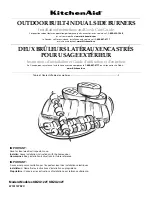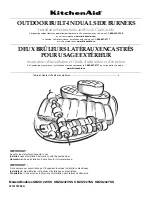
27829-5-0115
Page 12
H
W
L
1
L
2
FIREPLACE
DIVIDER
Example of Large Room with 1/2 Wall divider.
figure 4
The following formula can be used to determine the maximum heater
rating per the definition of unconfined space:
Btu/Hr =
(L
1
+ L
2
)fT x (W)fT x (H)fT
x 1000
50
If the area in which the heater may be operated is smaller than that defined
as an unconfined space, provide adequate combustion and ventilation
air by one of the methods described in the National Fuel Gas Code,
ANSI Z223.1, NFPA54.
Adhere to all codes, or in their absence, the latest edition of THE
NATIONAL FUEL GAS CODE ANSI Z223.1/NFPA54 which can be
obtained from:
American National Standards Institute National Fire Protection Associa-
tion, Inc.
11 West 42nd St.
Batterymarch Park
New York, NY 10018
Quincy, MA 02269
this heater shall not be installed in a confined space unless provisions
are provided for adequate combustion and ventilation air.
the national Fuel Gas Code defines a confined space as a space
whose volume is less than 50 cubic feet per 1,000 Btu per hour (4.8m
3
per kw) of the aggregate input rating of all appliances installed in that
space and an unconfined space as a space whose volume is not less
than 50 cubic feet per 1,000 Btu per hour (4.8 m
3
per kw) of the ag-
gregate input rating of all appliances installed in that space. Rooms
communicating directly with the space in which the appliances are
installed, through openings not furnished with doors, are considered a
part of the unconfined space.
unusually Tight construction
The air that leaks around doors and windows may provide enough fresh
air for combustion and ventilation. However, in buildings of unusually
tight construction, you must provide additional fresh air.
unusually tight construction is defined as construction
where:
a. Walls and ceilings exposed to the outside atmosphere have a
continuous water vapor retarder with a rating of one perm or
less with openings gasketed or sealed, and
b. Weatherstripping has been added on openable windows and
doors, and
c. Caulking or sealants are applied to areas such as joints around
window and door frames, between sole plates and floors, be
-
tween wall-ceiling joints, between wall panels, at penetrations for
plumbing, electrical, and gas lines, and at other openings.
If your home meets all of the three criteria above, you must provide
additional fresh air.
wArNING
If the area in which the heater may be operated is smaller than that
defined as an unconfined space or if the building is of unusually tight
construction, provide adequate combustion and ventilation air by
one of the methods described in the
National Fuel Gas Code, ANSI
Z223.1/NFPA 54, Air for Combustion and Ventilation,
or applicable
local codes.
PRoVISIoNS foR AdeQuATe coMBuSTIoN & VeNTILATIoN AIR
Содержание VFSM-18-3
Страница 27: ...27829 5 0115 Page 27 20 21 PARTS VIEW ...













































